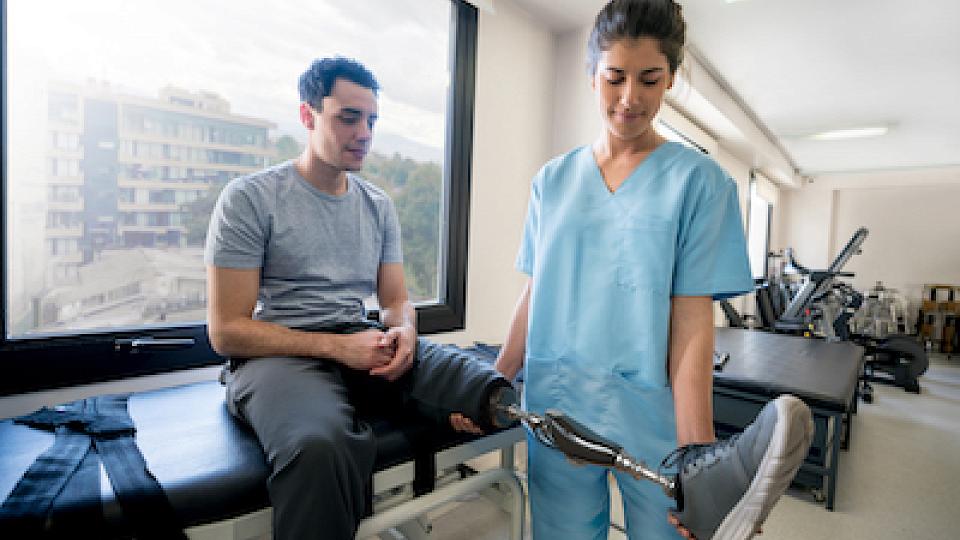Our Spasticity Management Program
Life-changing events may bring immense challenges such as spasticity, a complication of certain neurological conditions that can greatly interfere with your everyday life. At Craig H. Neilsen Rehabilitation Hospital, our highly trained rehabilitation specialists are committed to helping you restore your body’s movement and function for daily activities. We are the one of the only programs in the Mountain West region that offers comprehensive spasticity management.
Our multidisciplinary team takes a collaborative approach to bring you high-quality care and a customized treatment plan that fits your health needs and manages your spasticity symptoms. Our team consists of:
- physical therapists,
- occupational therapists,
- speech language pathologists,
- physiatrists,
- neurologists,
- nurses,
- nurse practitioners,
- neurosurgeons, and
- orthopedic surgeons.
Spasticity Symptoms
Spasticity is a form of muscle over-activity. The symptoms vary from person-to-person, but may include:
- mild muscle stiffness,
- severe, painful, and uncontrollable muscle spasms,
- contractures (permanent contraction of the muscle and tendon due to severe stiffness and spasms), and
- abnormal joint positions, which may lead to deformities or an inability to move the related body part.
Spasticity is often painful and can complicate your normal, everyday activities. Our rehabilitation specialists will help you regain your independence again by helping you reduce or manage your spasticity symptoms.
Spasticity Causes
Spasticity is caused by an injury to a part of the central nervous system that controls your voluntary movements. This type of damage disrupts the signals between your nervous system and muscles, leading to increased muscle activity. Spasticity may result from the following neurological conditions:
- stroke,
- brain injury,
- spinal cord injury,
- multiple sclerosis,
- cerebral palsy, or
- other neurological disorders.
Find a Spasticity Specialist
What to Expect at Your First Appointment
We will diagnose the severity of your spasticity at your initial appointment. During this evaluation, we will:
- perform a comprehensive physical examination to assess your spasticity and your overall level of function performing everyday activities such as walking and sleeping.
- discuss your medical history.
Spasticity Treatment Options
Spasticity can be managed in many ways. Our care team will work with you to design and implement a treatment program tailored to your needs. Some people may benefit from only one treatment option, while others may benefit from combining multiple treatment therapies.
Physical & Occupational Therapy
Our physical therapists will provide you with different stretches and exercises to improve your range of motion, mobility, and increase your strength. For occupational therapy, our therapists will address any problems you may have with performing everyday tasks. You will work with your occupational therapist on small muscle groups to improve your strength and coordination so you can regain your functionality.
Casting & Splinting
- Serial casting—A series of casts that we create over time to help increase your range of motion and decrease spasticity symptoms.
- Bracing—We offer comprehensive ankle, foot orthotic evaluations, and fittings.
- 3D-Splinting—This is an inexpensive, quick way to create a custom-fit splint for you. We scan a body part and then 3D-print the splint, which will help you maintain your flexibility and range of motion.
Oral Medications
Oral medications are often useful when several parts of your body are experiencing muscle spasticity or spasticity-related pain.
We prescribe the following medications for our patients:
Oral medications have the capacity to relax a large number of muscles, however, the effect on symptoms may only be modest in some people. If this is the case, we will use other therapies in conjunction with your medications to treat your spasticity.
Injections
Injection therapy is an in-office treatment that provides temporary relief from spasticity and helps relax the muscles. Options include:
- Botulinum toxin—This acts as a potent muscle relaxant that eases muscle spasms when directly injected into the muscle. It may take 10 to 14 days to take effect. We administer this injection once every three months.
- Phenol—This compound blocks over-active nerve signals to muscles, thereby reducing spasticity. This is administered once every three to six months or longer, depending on how your body responds to the injections. We may suggest this option when spasticity is localized to just a few areas, but the spasticity in those locations is severe.
Intrathecal Baclofen Pump Therapy
University of Utah Health has one of the largest baclofen therapy programs in the United States with more than 300 patients. We administer a liquid form of baclofen 24 hours a day directly into the fluid surrounding the spinal cord through an implantable pump and catheter (long, thin tube) system. This treats muscle spasms that are widespread in the body. This procedure is performed by a neurosurgeon and is an outpatient, same-day procedure.
Surgical Treatment
Neurosurgery and orthopedic surgery will focus on your brain, spinal cord, peripheral nerves, or muscles to treat spasticity or correct deformities resulting from spasticity. Surgical options include:
- neurectomies,
- tendon transfers,
- tendon lengthening for contracture management, and
- nerve transfers.
Your spasticity management provider will explore all of these options with you.
You will need a referral from your doctor to be admitted to our Spasticity Management Program at Neilsen Rehabilitation Hospital. Please call our clinic at 801-581-2267. Our referral specialist will work with your current provider to obtain necessary medical records and verify your insurance benefits for coverage.






